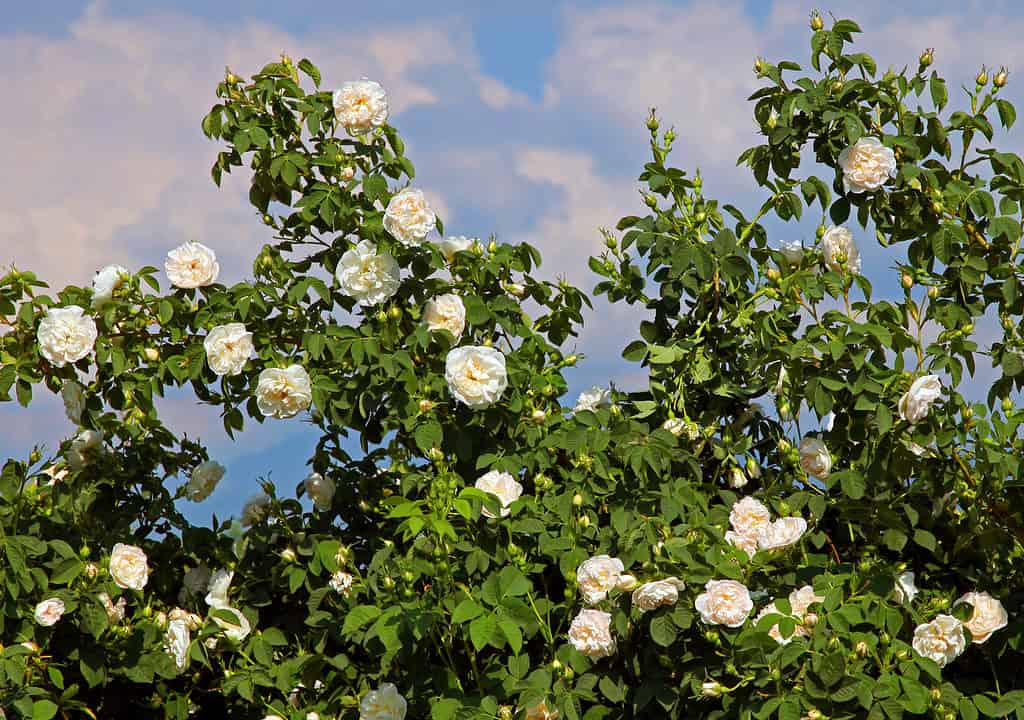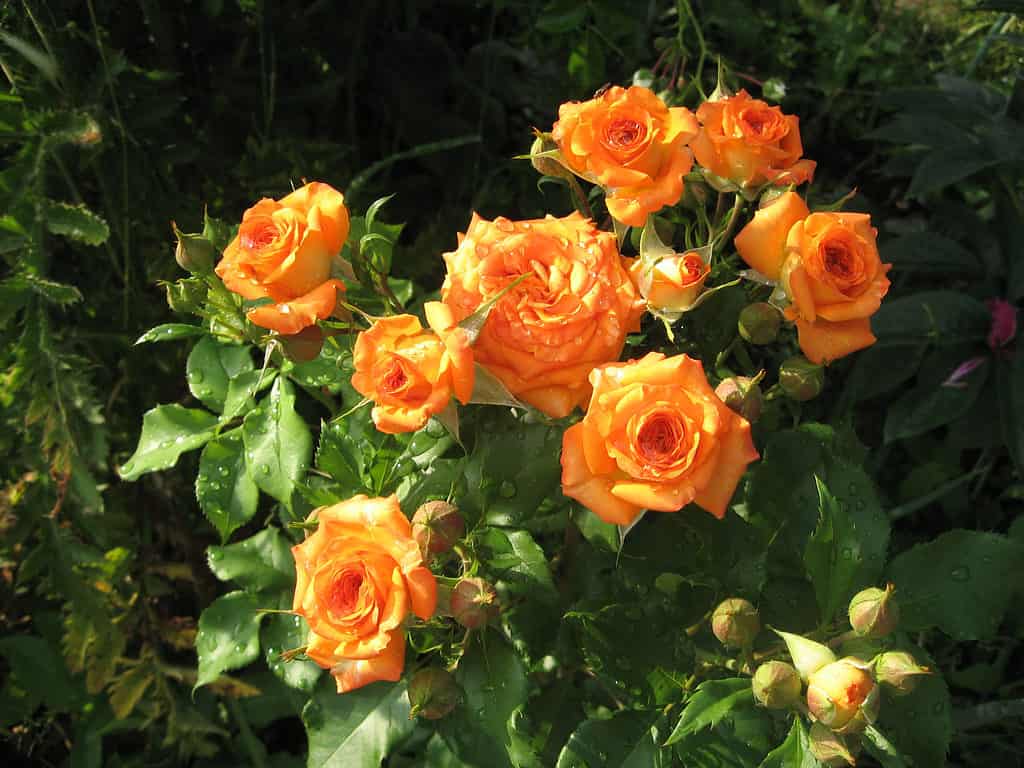There are endless roses categories and varieties out there. Choosing the right rose for your garden might be a bit of a daunting process. However, you simply can’t go wrong with an old rose, also known as an antique rose or vintage roses. And there are many types of vintage roses out there to choose from.
Old garden roses are a collection of rose bush varieties that were popular before 1867. The hybrid tea rose was initially made available in 1867, as well. These lovely roses can have a wide range of flowers in terms of scent, hue, and size. After their first spring blooming time, some of the rosebushes in this group will stop blossoming. However, when their rose hips develop, this group of rose bushes will further enhance the attractiveness of any garden or yard. When visiting an old garden rose in full bloom, guests will be delighted by the strong aroma of the classic old garden rose.
In this guide, we’ll look at what old roses are, the categories of old roses, and a few old rose varieties that have stood the test of time.
What are Old Roses?
As mentioned earlier, antique or old roses are a class of roses that existed and were popular before 1867. To put it simply, they are roses that existed before hybridization became the common practice in rose cultivation worldwide.
Vintage roses can be hard to find, as modern roses are much more popular nowadays and boast significantly more hybrids and cultivars. However, there are some benefits to planting antique roses. This rose class is known for years of developing excellent pest and disease resistance. Just as well, old roses have a very strong scent and can be perfect for gardens that are meant to delight the senses.
11 Different Types of Old Roses
There are five classes of old roses, including Gallica roses, moss roses, Alba roses, Damask roses, and Centifolia roses.
Gallica Roses
The earliest roses are Gallicas, which were first cultivated by the Greeks and Romans and then developed by the Dutch and French. They come in a wide variety of colors, some with striped flowers, and some have strong fragrances. Although they are small, they spread swiftly through subterranean runners and suckering, allowing them to fill in a space quickly. Their foliage has a rough texture and is dark green.
Moss Roses
The Victorian era’s preferred rose was the Moss rose. They have a pine-scented moss-like growth that has evolved on the sepals and calyx as a consequence of a naturally occurring genetic mutation. The moss rose can withstand neglect and is exceedingly disease-resistant. Just as well, some varieties can produce several blooms.

Alba roses (pictured) are popular in gardens for their strong scent.
©iStock.com/mimoza1d
Alba Roses
These roses have a strong fragrance and can grow in challenging environments, including partial shade. They grow tall and thin in an erect position and feature grey-green leaves and blush pink or white blossoms. They are also resistant to illness.
Damask Roses
Damask roses date back thousands of years, and it is believed that the Crusaders brought them from the Middle East to Europe. Others claim that they were brought to England by the Romans, while a third theory holds that Henry VIII’s physician sent him a Damask rose as a gift in the early 1540s. As it stands, though, their origin has been lost to time. They are quite prickly, but since they are so fragrant, they are used to make perfumes and oils. The bush of the Damask rose has an arching habit that can grow up to seven feet tall. Its flowers are white, pink, or red.
Centifolia Roses
Due to the size and form of its flowers, Centifolia roses are also known as cabbage roses. The size of this plant’s varieties ranges from one foot to 20 feet. Despite being exceedingly fragrant and winter-hardy, they are not as disease-resistant as some other old garden roses. They thrive in direct sunlight. White to deep purple make up the color spectrum of Centifolia rose.
In addition to these classes, there is another smaller group of old garden roses that are known for being able to bloom repeatedly. These include Noisette roses, China roses, Bourbon roses, tea roses, Portland roses, and hybrid perpetuals.
Noisette Roses
Prior to hybrid tea roses, noisettes were the first roses bred in America, coming from John Champney’s plantation in Charleston, South Carolina. Additionally, they were crucial for introducing the hues of orange and yellow to modern-day roses. They are descended from the China rose and are known for growing quite tall. Bushy plants from this class should be supported as climbers. They tolerate clay soils, have a pleasant scent, and are only marginally hardy in USDA hardiness zone seven.
China Roses
The original roses of this class were imported to Europe from China, where they were extensively crossed with roses from other classes. Repeat-flowering plants emerged as a result, revolutionizing the Western rose industry. They are a little delicate and can require protection in colder areas. They resist illness and have a pleasant scent. The blooms are smaller, smell a bit fruity, and appear in pink, copper, and red hues. The plant varieties of this class include robust climbers and little shrubs.
Bourbon Roses
These roses are named after the French-born European royal family and feature huge, fragrant blossoms as a general rule. With Bourbon rose varieties, there are usually three blossoms in a cluster. Although some may have a hefty shrub shape, this rose’s growth habits are often fairly lanky.
Tea Roses
In terms of cultivation and history, these roses are comparable to China roses. They are a hybrid of Rosa gigantea and Rosa chinensis. The majority of the blooms on the roses in this class are pink or crimson, and they often grow into thick, V-shaped bushes. Usually, tea roses only have five petals. This rose has a distinctive aroma that some people associate with tea. If the plant is severely pruned, it may not grow very well for a season and bear few flowers. It’s best to let this class of roses grow with minimal interference. This rose will first develop slowly, but it will get quite larger after two or three years. It is resistant to illness but delicate in USDA hardiness zone eight.
Portland Roses
The mid-1800s saw a rise in the popularity of Portland roses. They are descended from China, Damask, and Gallica roses. The multi-petaled, very fragrant blooms of this rose class are often pink and have light green leaves. This shrub is perfect for small gardens or containers because it is typically less than 12 inches tall and has tiny blossoms.
Hybrid Perpetual Roses
This rose is the hybrid tea rose of the 19th century. Large, double roses on these rose plants bloom in pink, purple, red, and occasionally white. They feature a regal, erect arching growth and a strong, exquisite smell.
5 Varieties and Types of Old Roses

The Queen Elizabeth rose (pictured) is one of the most beloved old or vintage roses grown today.
©iStock.com/akimari
Queen Elizabeth Rose
Botanical Name: Rosa ‘Queen Elizabeth’
The old grandiflora rose, called Queen Elizabeth rose, is a classic antique variety. It has a spread of two to three feet and grows to a height of four to six feet. This rose blooms in May, although it will continue to bloom intermittently throughout the fall. It features fragrant double blossoms. Although it is pink, it has an almost white or silvery shimmer to it. The USDA hardiness zones six through 11 are suitable for growing this rose, which needs full sun and acidic, well-draining soil.
Duchess of Portland Rose
Botanical Name: Rosa ‘Duchess of Portland’
This antique rose variety is one of the Portland roses. The four different rose species that make up the modest assortment of roses known as Portland roses were produced in Great Britain. Its three-inch-wide, semi-double, single, scarlet, or deep-pink blooms have a light fragrance. It develops to a height of three to four feet and a width of three feet. In late spring or early summer, this plant begins to blossom. USDA hardiness zones four through nine are ideal for the Dutchess of Portland rose. It demands full light and consistently wet, well-drained soil.
Old Red Damask Rose
Botanical Name: Rosa gallica ‘Officinalis’
This Gallica rose is also known as the French rose or Rose of Provins. One of the first rose species to be cultivated in central Europe was Rosa gallica. You must plant Gallica roses like this one if you enjoy heirloom roses for their heritage and history! Light red, semi-double blooms with golden stamens are produced by this cultivar. The blooms, which have a strong scent, bloom from late spring until mid-summer. When fully grown, the bush is three to five feet tall and broad. This rose may be planted in USDA hardiness zones four through 11, prefers full sun, and needs neutral soil with good drainage.
Omar Khayyam Rose
Botanical Name: Rosa ‘Omar Khayyam’
The Omar Khayyam rose is a type of Damask rose. The renowned Islamic poet is referenced in this rose’s name. According to legend, it grew at his tomb in Persia. This rose extends out to about three feet wide and reaches two to three feet tall. The double pink flowers are somewhat fragrant and will bloom from May through June. This variety’s lovely roses are about two inches wide. This rose prefers full sun, grows best in slightly acidic and well-draining soil, and is hardy in USDA hardiness zones four through nine.
Fantin-Latour Rose
Botanical Name: Rosa ‘Fantin-Latour’
The Provence rose is another name for this Centifolia rose. Large, fragrant blooms are created by overlapping, thin, and fragile petals that frequently drop off branches due to their weight. The double pink blossoms of the Fantin-Latour rose have a delightful perfumey scent. This flower blooms in the late spring, and the bushes may reach four to six feet tall and broad. USDA hardiness zones five through 11 are favorable for this rose’s growth. It requires both full light and soil that drains properly for it to develop.

Modern rose varieties (pictured) tend to lack the hardiness and strong scent of old garden roses.
©FarbaKolerova/Shutterstock.com
Which Old Rose Should I Grow?
So you want to plant an heirloom rose in your yard to add a little bit of history and fragrance to your life. Where can you start? To view and smell these roses in their natural habitat, we advise going to one of your city’s local nurseries or gardens. In many public heirloom gardens, roses that are grown there are also for sale. If such gardens aren’t near you, try searching online via specialty online nurseries.
With so many beautiful antique roses available, finding the right variety for your garden won’t be too difficult. You really can’t beat the classic appearance and hardiness of old roses!
The photo featured at the top of this post is © iStock.com/kit yu
Sources
- NCSU Staff, Available here: https://plants.ces.ncsu.edu/plants/rosa/
- Sheryl Geerts, Available here: https://www.bhg.com/gardening/flowers/roses/ultimate-rose-care-guide/
- Sue Martin, Available here: https://piedmontmastergardeners.org/article/heirloom-or-old-garden-roses/
FAQs (Frequently Asked Questions)
What are old roses known as?
Old roses are often called heirloom roses or antique roses.
What is the oldest type of rose?
Rosa gallica officinals is considered the oldest existing rose, known for being extremely fragrant.
What is the oldest rose color?
Pink in considered the oldest rose color.
Thank you for reading! Have some feedback for us? Contact the AZ Animals editorial team.






